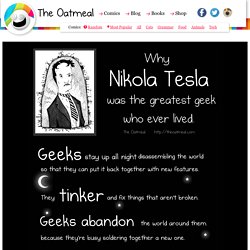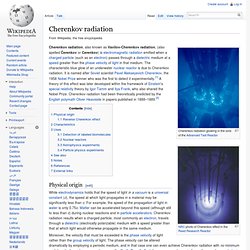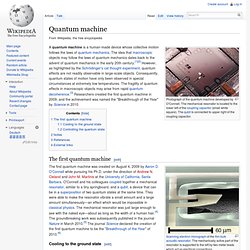

Why Nikola Tesla was the greatest geek who ever lived. Additional notes from the author: If you want to learn more about Tesla, I highly recommend reading Tesla: Man Out of Time Also, this Badass of the week by Ben Thompson is what originally inspired me to write a comic about Tesla.

Universe Sandbox. Video. Bad Science. How to Glow on the Go: Cup of Light-Up Neon Yellow ‘Tea’ Caution: do not consume.

Like the infamously dosed Kool-Aid, this is one cool liquid refreshment that you do not want to drink – just add a ‘tea bag’ and carry the cups where you require illumination. This ingenious glow-in-the-dark liquid concoction will light up your glass, bounce off the ceiling above and dance on table surface around it. Like a modern version of the Wonka candy factory, it might make your face go the bright green, red or yellow colors of those party-favor glowing bracelets, necklaces and light sticks.
Cherenkov radiation. Cherenkov radiation, also known as Vavilov-Cherenkov radiation, (also spelled Čerenkov or Cerenkov) is electromagnetic radiation emitted when a charged particle (such as an electron) passes through a dielectric medium at a speed greater than the phase velocity of light in that medium.

The characteristic blue glow of an underwater nuclear reactor is due to Cherenkov radiation. It is named after Soviet scientist Pavel Alekseyevich Cherenkov, the 1958 Nobel Prize winner who was the first to detect it experimentally.[1] A theory of this effect was later developed within the framework of Einstein's special relativity theory by Igor Tamm and Ilya Frank, who also shared the Nobel Prize. Cherenkov radiation had been theoretically predicted by the English polymath Oliver Heaviside in papers published in 1888–1889.[2] Physical origin[edit] Is the Universe a Holographic Reality?
The Universe as a Hologram by Michael Talbot Does Objective Reality Exist, or is the Universe a Phantasm?

In 1982 a remarkable event took place. At the University of Paris a research team led by physicist Alain Aspect performed what may turn out to be one of the most important experiments of the 20th century. You did not hear about it on the evening news. In fact, unless you are in the habit of reading scientific journals you probably have never even heard Aspect's name, though there are some who believe his discovery may change the face of science. Aspect and his team discovered that under certain circumstances subatomic particles such as electrons are able to instantaneously communicate with each other regardless of the distance separating them. University of London physicist David Bohm, for example, believes Aspect's findings imply that objective reality does not exist, that despite its apparent solidity the universe is at heart a phantasm, a gigantic and splendidly detailed hologram. Quantum machine.
Photograph of the quantum machine developed by O'Connell.

The mechanical resonator is located to the lower left of the coupling capacitor (small white square). The qubit is connected to upper right of the coupling capacitor. The first quantum machine[edit] Cooling to the ground state[edit] Nanotechnology is coming. By Ralph C.

Merkle, Principal Fellow, Zyvex. Photopic Sky Survey. Quantum Mechanics. New kind of light created in physics breakthrough. Physicists have created a new kind of light by chilling photons into a blob state.

Just like solids, liquids and gases, this recently discovered condition represents a state of matter. Called a Bose-Einstein condensate, it was created in 1995 with super-cold atoms of a gas, but scientists had thought it could not be done with photons, which are basic units of light. Scientists Develop Affordable Solar Panels That Work In The Dark. It's about damn time, don't you think?

Scientists at Lawrence Berkeley National Laboratory announced Wednesday that they have been able to confirm a new high-efficiency solar cell design that utilizes nearly the entire solar spectrum. Translation: They figured out a way to make solar panels generate electricity in the dark. CleanTechnica says , In earlier trials, the researchers used different alloys that achieved full spectrum responses but involved very high production costs. Distances from the Sun. Bracing the Satellite Infrastructure for a Solar Superstorm: Scientific American Slideshows. Email September 3–4 Main phase of geomagnetic disturbances from second CME ends; scattered auroral sightings continue, but with diminishing intensity.....[ More ] Main phase of geomagnetic disturbances from second CME ends; scattered auroral sightings continue, but with diminishing intensity.[ Less ] [ Link to this slide ]

Solar Storms can Change Directions, Surprising Forecasters. Solar Storms can Change Directions, Surprising Forecasters Sept. 21, 2010: Solar storms don't always travel in a straight line.

But once they start heading in our direction, they can accelerate rapidly, gathering steam for a harder hit on Earth's magnetic field. So say researchers who have been using data from NASA's twin STEREO spacecraft to unravel the 3D structure of solar storms. Their findings are presented in today's issue of Nature Communications. "This really surprised us," says co-author Peter Gallagher of Trinity College in Dublin, Ireland.
Timeline: The 1859 Solar Superstorm. The solar superstorm of 1859 was the fiercest ever recorded. Auroras filled the sky as far south as the Caribbean, magnetic compasses went haywire and telegraph systems failed. Ice cores suggest that such a blast of solar particles happens only once every 500 years, but even the storms every 50 years could fry satellites, jam radios and cause coast-to-coast blackouts.